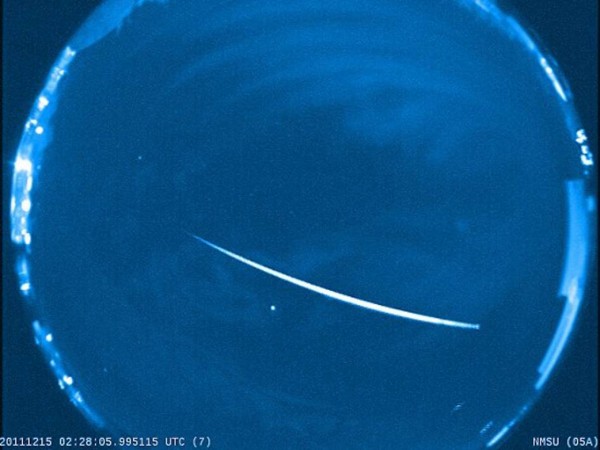How to Watch the Best Meteor Shower of 2015: Geminids Peak Tonight
| Ana Verayo | | Dec 13, 2015 08:32 AM EST |
(Photo : NASA) On Dec.13, meteor experts from NASA’s Meteoroid Environment Office will answer questions during a live Tweet Chat about the Geminid meteor shower from NASA’s Marshall Space Flight Center.
The Geminid meteor shower will provide a dazzling array of shooting stars during the nights of December 13 and 14 where astronomers believe that this will be the best meteor shower of the year.
The Slooh Community Observatory will set up a live webcast of the Geminids beginning on Sunday, December 13 at 6 P.M. EST which will also be hosted by Slooh's Community Manager and astronomy expert Paul Cox. The webcast will show stunning views of the Geminids from five different countries from four continents where viewers will also be treated to a crash course on astronomy, about how this particular meteor shower is born.
Like Us on Facebook
During the nights of December 13 and 14, NASA reveals that under ideal viewing conditions and away from light pollution, stargazers will be able to spot as many as 100 meteors every hour. These "shooting stars" that are observed during a typical meteor shower are actually bits of space rock falling and burning up into the Earth's atmosphere.
This yearly Geminid meteor shower comes from debris from a space object known as 3200 Phaethon. NASA says that this 3200 Phaethon is apparently long thought to be an asteroid however it is now classified as an extinct comet or a dead comet meaning, water ice and other volatiles on its surface are all completely gone due to evaporation, leaving a rocky remnant. As Earth passes through this trail of debris every year, these shooting stars appear to originate from the skies in the constellation Gemini.
Apart from multiple stunning views of the meteor shower from around the world, Slooh will also share interesting facts about the Geminids such as its rocky comet origins that causes this active shower and also the origin of the name "Geminids" hailing from the mythology of the Gemini twins, Castor and Pollux.
Slooh will also provide tips how viewers can also "hear" meteors and of course, how to spot them and even a quick photography tutorial how to capture these meteors.
Apart from this, NASA's Marshall Space Flight Center in Alabama will host a live chat on Twitter about the meteor shower on the night of December 13 beginning 11 P.M. EST until 3 A.M. EST of December 14. The live tweet chat will feature NASA astronomy experts, Bill Cooke, Danielle Moser and Rhiannon Blaauw, where they will provide their insights about the meteor shower and also answer questions for those who want to participate to tweet their questions to @NASA_Marshall or use the hashtag #askNASA.
For viewers located in the Northern Hemisphere, to prepare for this meteor shower, make sure to bundle up before going outside and be updated about weather reports for clear night sky viewing. It will also take at least 20 minutes to adjust your eyes in the darkness in order to spot the shooting stars.
Tagsgeminids meteor shower, geminids, geminid meteor shower 2015, how to watch meteor shower geminids, watch online geminids meteor shower 2015, meteors, meteor shower, watch live geminids meteor shower
©2015 Chinatopix All rights reserved. Do not reproduce without permission
EDITOR'S PICKS
-

Did the Trump administration just announce plans for a trade war with ‘hostile’ China and Russia?
-

US Senate passes Taiwan travel bill slammed by China
-

As Yan Sihong’s family grieves, here are other Chinese students who went missing abroad. Some have never been found
-

Beijing blasts Western critics who ‘smear China’ with the term sharp power
-

China Envoy Seeks to Defuse Tensions With U.S. as a Trade War Brews
-

Singapore's Deputy PM Provides Bitcoin Vote of Confidence Amid China's Blanket Bans
-

China warns investors over risks in overseas virtual currency trading
-

Chinese government most trustworthy: survey
-

Kashima Antlers On Course For Back-To-Back Titles
MOST POPULAR
LATEST NEWS
Zhou Yongkang: China's Former Security Chief Sentenced to Life in Prison

China's former Chief of the Ministry of Public Security, Zhou Yongkang, has been given a life sentence after he was found guilty of abusing his office, bribery and deliberately ... Full Article
TRENDING STORY

China Pork Prices Expected to Stabilize As The Supplies Recover

Elephone P9000 Smartphone is now on Sale on Amazon India

There's a Big Chance Cliffhangers Won't Still Be Resolved When Grey's Anatomy Season 13 Returns

Supreme Court Ruled on Samsung vs Apple Dispute for Patent Infringement

Microsoft Surface Pro 5 Rumors and Release Date: What is the Latest?










